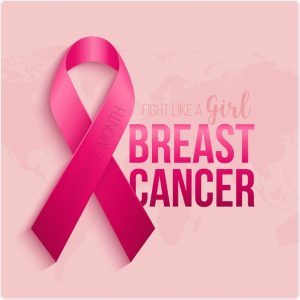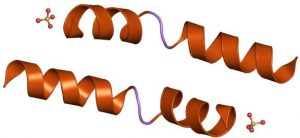22 3.1 Introduction
Overview
In this chapter, we will learn about breast cancer and the potential treatments options offered. We will further examine current research utilizing apitherapy as a potential treatment option for breast cancer, as well as, discuss how researchers have utilized honeybee venom and melittin to target the most aggressive breast cancer subtypes. At the end, we will examine the significance of apitherapy for breast cancer research, and as well as, summarize key points of this chapter.
- Overview of the Structure of the Breast (Image retrieved from: https://pathology.jhu.edu/breast/overview/).
Breast Cancer

Breast cancer is a cancer that forms in the cells of the breasts. It can occur in both men and women; however, breast cancer is far more common in women. According to the Canadian Cancer Society, approximately 27,400 women will be diagnosed with breast cancer. This number of breast cancer cases represents 25% of all new cancer cases that occur in women in the year of 2020 (Canadian Cancer Society).
Risk Factors
There are a variety of risk factors that a doctor must consider when diagnosing a person with breast cancer. There are several genetic and environmental factors that come into play when diagnosing an individual with breast cancer, especially since there are many factors that can increase a person’s risk for breast cancer. Below is a list of a few risk factors that must be taken into consideration when diagnosing an individual with breast cancer :
- Personal History and Family History of Breast Cancer
- Known Genetic Mutations, such as BRCA gene mutations and others
- Reproductive and Hormonal Factors
- Environmental Factors, such as alcohol, exposure to ionizing radiation

It is important to know the risk factors because there are many ways to increase or decrease a person’s risk of developing breast cancer i.e., there are ways to prevent developing breast cancer and it is important to know how to do so.
Treatments:
There are many factors to consider when treating a person with breast cancer, such as the HER2 stage of the cancer, if you have reached menopause, the hormone receptor status of the cancer, the HER2 status of the cancer, the recurrence of the cancer and one’s overall health. From this, there are several treatment options that can be offered. Below is a table of the treatments that may be offered in conjunction with others (please note that these are not the only treatment options offered):
| Types of Treatments | How does it work? |
|---|---|
| Surgery | - Removal of cancer cells from breasts - It depends on many factors, such as: size and location of the tumor, size of the breast, if cancer has spread to the lymph nodes, If you have been offered other treatments for breast cancer |
| Radiation Therapy | - Uses a machine to direct radiation through the skin to the tumor and the surrounding tissue - It is typically provided after surgery and especially to treat breast cancer that has spread to the bones, lungs or brain |
| Chemotherapy | - The use of chemical substances to treat breast cancer - Commonly used treatment for breast cancer (main treatment for advanced or metastatic breast cancer) - Often given after surgery to treat early stages of breast cancer in order to reduce the risk of recurrence of the cancer - Combinations of chemotherapy and other drugs are more effective than the use of a single drug |
| Hormonal therapy | - This treatment is often used to treat hormone receptor-positive breast cancer |
| Targeted therapy | - Treatment targeted at combining treatments, such as chemotherapy, hormonal therapy or both |
From this, there are a variety of treatments offered; however, with every treatment comes harmful side effects and experiences, which is why researchers are interested in developing an effective treatment with minimal effects on healthy cells.
Below is a video regarding “Honeybee venom found to kill cancer”:
Definitions:
Apitherapy as a Potential Treatment:
Research is directed towards developing and optimizing novel treatments that are effective, natural, widely available and cost-effective. Apitherapy serves as a great therapeutic to do so since honeybee has been medicinally used by humans for thousands of years.
Honeybee venom is made up of the active component, melittin. Melittin makes up half of honeybee venom by dry weight and it is a positively charged, amphipathic 26-amino-acid peptide. Melittin associates with phospholipids of the membrane bilayer causing cell death because it enables the internalization of additional small molecules with cytotoxic activities. This is important because both honeybee venom and melittin have demonstrated to have antitumoral effects on a wide variety of cancers, such as leukemia, melanoma, ovarian, cervical, pancreatic and other cancers. However, what remains unknown, or poorly understood about this research field is the molecular determinants of the anticancer activity of honey bee venom and melittin in breast cancer cells.

Breast Cancer Subtypes
Treating breast cancer requires an understanding of the tumor expression of predictive and prognostic biomarkers. By understanding the different breast cancer subtypes, we can then identify and understand the effects of honeybee venom and melittin across breast cancer subtypes compared to non-transformed cells, i.e., healthy (normal) cells.
The main breast cancer subtypes this chapter will focus on are: Human epidermal growth factor receptor 2-enriched (HER2-enriched) and Triple-negative breast cancers (TNBCs). Below is a table of the two breast cancer subtypes and their respective definitions:
| Breast Cancer Subtypes | Definitions |
|---|---|
| Human epidermal growth factor receptor 2-enriched (HER2-enriched) | - HER2-enriched breast cancers are both hormone-receptor negative (estrogen-receptor and progesterone-receptor negative) and HER2 positive. These cells grow faster and have a worse prognosis compared to luminal cancers; however, they can often be treated with targeted therapies aimed at targeting HER2 protein. - Therapies targeted at HER2-enriched has been established for only short-time periods but resistance is seen over a longer-time period - HER2-enriched overexpress HER2, which is another receptor tyrosine kinase (RTK) that confers oncogenic signaling, dependent on the P13K/Akt pathway downstream |
| Triple-negative breast cancers (TNBCs) | - TNBCs are both hormone-receptor negative (estrogen-receptor and progesterone-receptor negative) and HER2 negative. - This type of breast cancer is more common in women with the BRCA1 gene mutations. - TNBCs overexpress epidermal growth factor receptor (EGFR) |
Below is a video that briefly describes how Receptor Tyrosine Kinases (RTKs) cell signaling works (for HER2-enriched breast cancer cells):
Key Takeaways
- Breast cancer is a cancer that forms in the cells of the breasts
- There are many risk factors to consider when treating a person with breast cancer
- There are many treatment options; however, current research is focused on the use of apitherapy (i.e., the use of honeybee venom and melittin)
- Breast Cancer Subtypes this chapter will focus on are HER2-enriched and TNBCs
References
- Breast Cancer. (2020, November 20). Retrieved November 30, 2020, from https://www.cancercareontario.ca/en/types-of-cancer/breast-cancer
- Duffy C., Sorolla A., Wang E., Golden E., Woodward E., Davern K., Ho D., Johnstone E., Pfleger K., Redfern A., Iyer K. S., Baer B, & Blancafort P. (2020). Honeybee venom and melittin suppress growth factor receptor activation in HER2-enriched and triple-negative breast cancer. NPJ Precision Oncology, 4(24), 1-24. doi:10.1038/s41698-020-00129-0
- NCI Search Results. (n.d.). Retrieved December 1, 2020, from https://www.cancer.gov/search/results?swKeyword=Her2
- Ovarian Cancer Risk Factors and Prevention. (n.d.). Retrieved November 30, 2020, from https://ocrahope.org/patients/about-ovarian-cancer/risk-factors/
- Symptoms & Risk Factors. (n.d.). Retrieved November 30, 2020, from https://pathology.jhu.edu/breast/symptoms-risk-factors
- What is breast cancer? – Canadian Cancer Society. (n.d.). Retrieved November 30, 2020, from https://www.cancer.ca/en/cancer-information/cancer-type/breast/breast-cancer/?region=on

